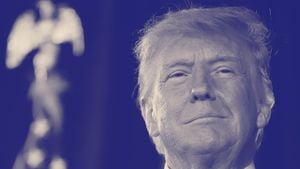With Donald Trump’s recent win shaking the global economic stage, the euro has taken quite the tumble, creating ripples of speculation on whether this sliding currency might soon reach parity with the U.S. dollar. Following the election results, the euro fell to around $1.05, marking its first major decline since September of the previous year. This decline has raised eyebrows and questions: could we see the euro trading below the dollar again, and what would such a move mean for businesses and households across Europe?
The euro-dollar pairing is the most actively traded currency contraposition globally, and any fluctuations here can significantly influence market trends. This isn't just about numbers on a spreadsheet—this impacts everyday lives and the economy at large. A 6% drop isn’t trivial; it's igniting concerns about higher tariffs under Trump's leadership, which could pose serious challenges to the eurozone's already strained economic stance.
So, what exactly does hitting the $1 mark imply? For many traders, this threshold isn't simply psychological; it holds substantial market weight. A noted decline below this level could more broadly affect sentiment concerning the euro, potentially leading to increased sell-offs and, hence, lowering the euro’s value even more. Major financial institutions like JPMorgan and Deutsche Bank are observing this situation closely, as they predict the potential for hitting this parity, influenced primarily by tariffs and shifting fiscal policies.
Now, translate these currency shifts to everyday life—what does it mean for the average consumer? A weaker euro signals increased import costs, exacerbated by the rising prices for raw materials, energy, and food. While inflation rates have eased from their peak two years ago, many are wondering how much strain renewed currency weakness will put on household budgets. Yet it’s not all doom and gloom; the lower euro rate could also bolster exports considerably, which may be great news for sectors like automobile manufacturing, luxury goods, and tourism. For German exporters especially, the prospect of cheaper products abroad could stimulate greater sales—maybe even compensatory efforts should domestic pressures mount.
When considering the euro's performance against other currencies, it is notable how it's faring relative to U.S. trading partners. The euro has shed over 4.5% of its value recently, contrasting with others like the Mexican peso, which dropped 6%, or the Korean won, down 5.4%. Such losses aren’t unique to the euro, but they do highlight the brewing storm around Trump’s possible tariff policies, weighing heavily on global trades.
Interestingly, during Trump's first stint as president, the euro did see some positive movement with a rise, but history tends to paint a different picture during times of political turmoil—a decline can follow swiftly. Since the election results were declared, the euro has dipped almost 6%, echoing trends witnessed following past elections.
The burning question now is whether parity with the dollar is genuinely on the horizon, or if it’s merely noise. Various analysts maintain cautious optimism about the euro’s potential recovery, citing the possibility of quicker interest rate adjustments by the European Central Bank (ECB) as pivotal. The eurozone’s economic performance, showing some growth—specifically, 0.4% expansion noted recently—offers room for hope. Economic adjustments and shifts can be unpredictable, but signs of renewed growth might just provide the euro with the air it needs to float above turbulent waters.
Should Trump's administration implement substantial tariffs, Goldman Sachs anticipates there could be as much as a 10% drop of the euro against the dollar. Should this come to fruition, it raises broader economic ramifications and challenges, especially for the eurozone, which continues to recover from previous instabilities.
With all this said, there are whispers of cautious optimism. The economic outlook may not be as gloomy as some predict. Benjamin Melman, chief investment officer at Edmond de Rothschild, noted, "Everyone is gloomy on Europe and we understand the gloominess but we could have some positive surprises." Perhaps the euro can pull through—grasping for upward momentum as policy landscapes evolve under the new American leadership.
Through this delicate choreography of currency and policy, the euro is caught between the dual forces of American tariff strategies and Europe's own internal fiscal moves. Only time will tell whether the euro can reclaim its standing or if the dollar's dominance takes another leap forward.



